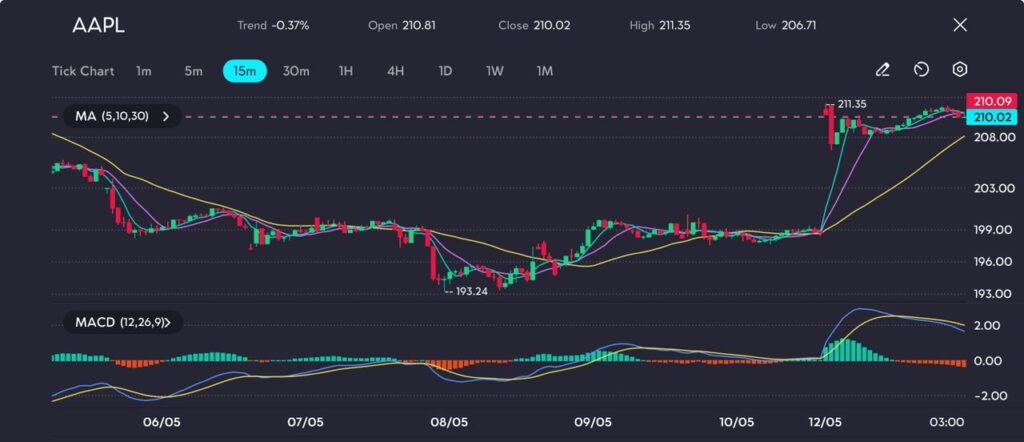
Apple shares jumped after news broke of a temporary pause in US tariffs on Chinese goods, offering some relief to investors worried about the company’s exposure to trade tensions. The move comes at a crucial time for Apple, which has been under growing pressure because of its strong dependence on Chinese manufacturing.
Apple Inc. (AAPL) saw its share price jump by 6.1% on Monday, closing at USD 210.79, after former President Donald Trump confirmed a 90-day pause on elevated tariffs targeting Chinese imports.
The announcement helped calm investor nerves, particularly given Apple’s substantial dependence on manufacturing in China.
This rally positioned Apple as one of the top performers among the ‘Magnificent Seven’ tech stocks, despite the broader year-to-date picture remaining negative.
So far in 2025, AAPL shares are still down over 13%, pressured by persistent geopolitical tensions and ongoing concerns around supply chain stability.
Back in April, Trump’s declaration that tariffs on Chinese goods could rise as high as 145% rattled markets.
Apple shares fell sharply following the news, as roughly 90% of iPhones—which contribute nearly half of Apple’s quarterly revenue—are assembled in China.
During the company’s 1 May earnings call, CEO Tim Cook acknowledged the risks and outlined plans to expand iPhone production in India.
While this move aims to diversify Apple’s manufacturing footprint and reduce reliance on China, it also introduces potential logistical challenges and increased production costs, which could weigh on profit margins in the short term.
The new, reduced 30% tariff rate, set for the 90-day window, provides temporary relief but does little to eliminate uncertainty around long-term trade relations.
Trump also suggested Apple is planning substantial domestic investment, claiming in a Monday press conference: “I spoke to Tim Cook this morning… he’s going to be building a lot of plants in the United States for Apple.”
He hinted at a possible USD 500 billion reshoring roadmap, though no formal details have been confirmed.
Apple (AAPL) has staged a strong technical rebound, rallying from a recent low of USD 193.24 to push beyond the key USD 210 resistance level, peaking at USD 211.35.
This move was accompanied by a bullish MACD crossover and a notable expansion in histogram bars—indicators of solid short-term momentum.

Currently, the stock is consolidating above the 10-period moving average, while the 30-period MA begins to slope upward—a technical shift often supportive of continued upside momentum.
Despite minor cooling in MACD strength and histogram compression, the price remains resilient above USD 208, suggesting buy-the-dip activity is still in play.
If the structure of higher lows remains intact and AAPL can break cleanly above USD 211.35, a push towards the USD 213–USD 215 zone appears feasible in the coming sessions.
Although the recent tariff pause has buoyed short-term sentiment and triggered a sharp recovery in Apple’s share price, the broader outlook remains mixed.
Much of Apple’s near-term performance may hinge on how well the company navigates its evolving production strategy across China, India, and potentially the United States.
Diversifying manufacturing is a sensible move to reduce geopolitical risk, but it also brings higher operational costs, logistical hurdles, and execution risks that could pressure margins.
If trade tensions escalate again or Apple fails to communicate a clear, long-term roadmap for its global supply chain, investor confidence could weaken, leading to a pullback in the stock—possibly below the USD 200 mark.
Traders and investors should remain cautious, keeping a close eye on geopolitical developments, policy announcements, and any updates from Apple regarding production shifts.
Volatility is likely to persist as the company balances growth ambitions with complex global risks.
Click here to open account and start trading.